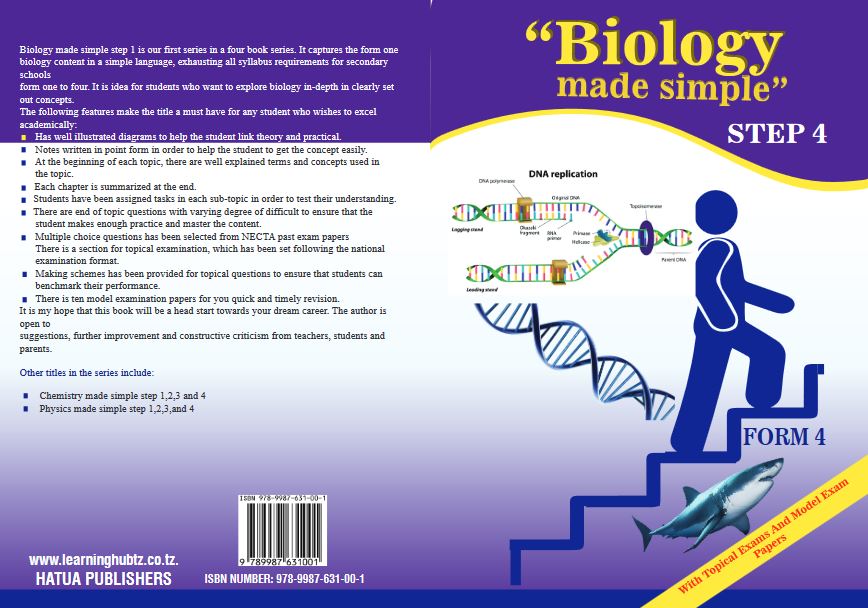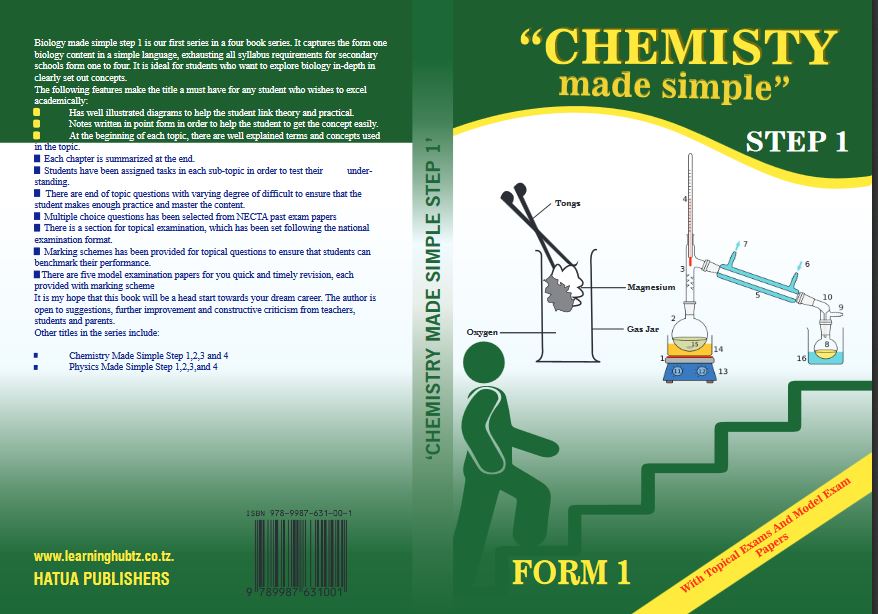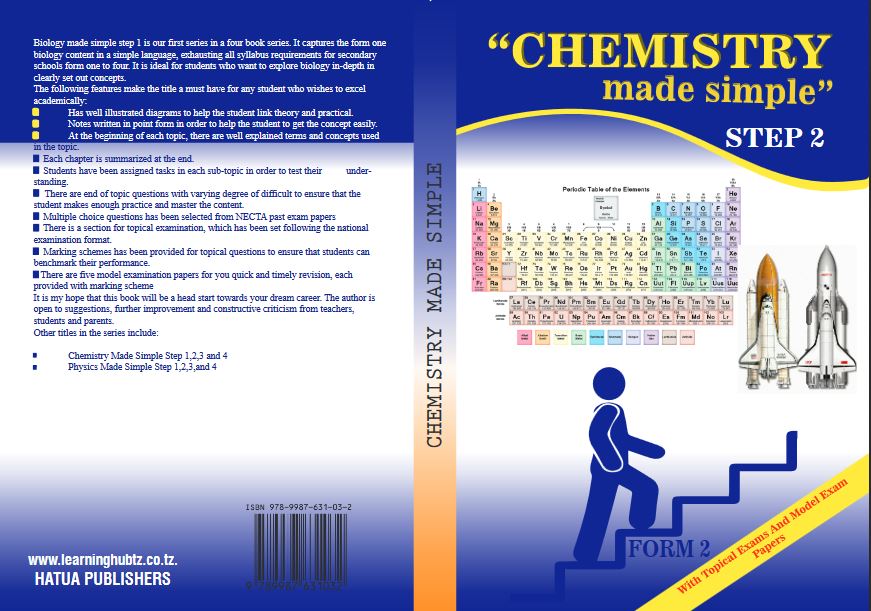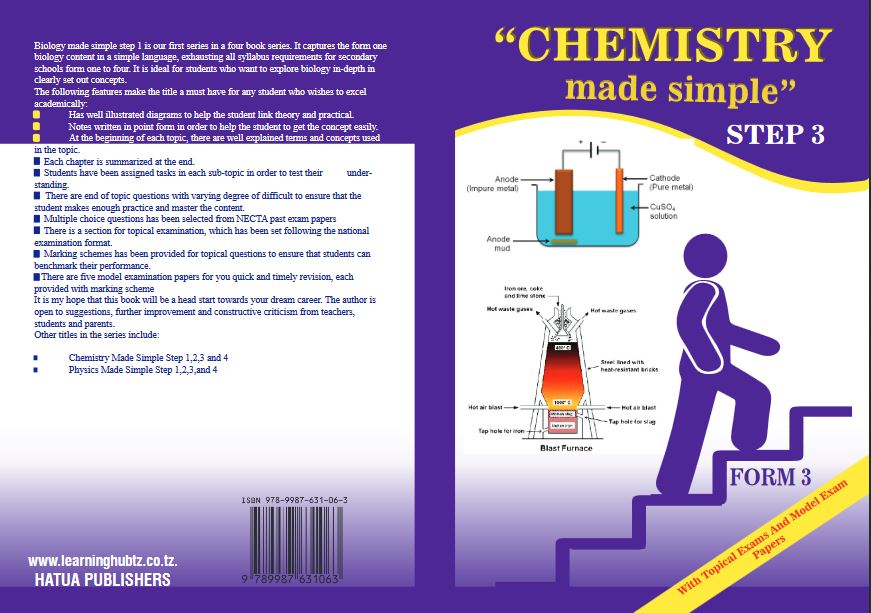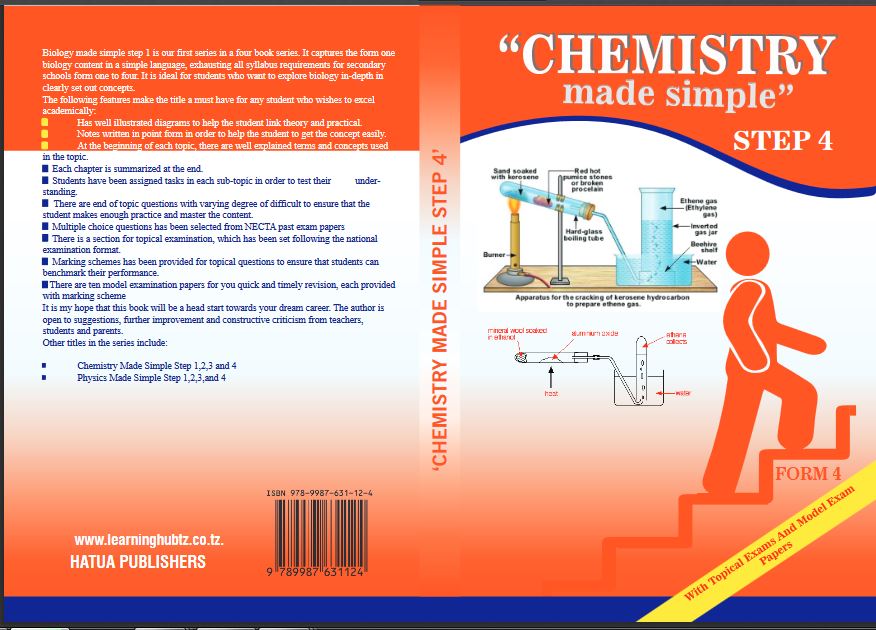
FORM THREE BIOLOGY EXAM SERIES 215
FORM THREE BIOLOGY EXAM SERIES 215
FORM THREE BIOLOGY EXAM SERIES 203
FORM THREE BIOLOGY EXAM SERIES 203
PRESENT’S OFFICE, REGIONAL ADMINISTRATION
AND LOCAL GOVERNMENT
SECONDARY EXAMINATION SERIES
COMPETENCY BASED EXAMS
BIOLOGY FORM THREE
MID-TERM EXAMS – AUGUST/SEPT – 2024
TIME: 2:30 HRS
INSTRUCTIONS
1. This paper consists of section A, B and C with a total of eleven (11) questions
2. Answer all questions in section A and B and two (2) questions from section C.
3. Section A carries sixteen (16) marks, section B carries fifty four (54) marks and section C carries thirty (30) marks.
4. All writings must be in blue or black ink except drawings which should be in pencil.
5. All communication devices, programmable calculators and any unauthorized materials are not allowed in examination room.
6. Write your examination number on every page of your answer sheet(s).
SECTION A (15 MARKS)
i. The immediate result of fertilization in a flowering plant is the formation of
- zygote
- seed
- endosperm
- Embryo
ii. Which of the following is not an excretory product in plants;
- Tannis
- Carbondioxide
- Urea
- Calcium oxalate
- Latex
iii. Joints are held together by;
- Ligaments
- Cartilage
- Tendon
- Muscles
- Bones
iv. A rise in the body temperature of human body is corrected by
- Constriction of the skin arteries and sweating
- Constriction of the skin arteries and shivering
- Dilation of the skin arteries and sweating
- Dilation of the skin arteries and shivering
v. Which of the following statement gives the common cause of cretinism (feeble mindedness)
- Lack of balanced diet
- Lack of coordination between the nerves and endocrine system
- Poor functioning of the adrenal gland in childhood
- Poor functioning of the thyroid gland in childhood
vi. Which of the following is not an advantage of angiosperms?
A. They are source of food
B. Some have medicinal values
C. Acts as wind breakers
D. Sources of timber.
vii. Guttation is the:
- Loss of water vapor from leaves
- Excretion of excess water droplets from leaves
- Absorption of water by roots
- Movement of water through xylem
viii. The first site of digestion of protein is in the,
- Mouth
- Oesophagus
- Stomach
- Small intestine
ix. Which of the following is NOT a characteristic of Euglena?
- It has chloroplasts for photosynthesis.
- It has a cell wall.
- It has an eyespot for detecting light.
- It can move using a flagellum.
x. Which of the following is not a feature of paramecium?
- They are autotrophic
- They use contractile vacuole to regulate water in their body
- Can produce both sexually and asexually
- Their body is covered with pellicle
2. Match the words on the left hand COLUMN A with the correct statement on the right hand COLUMN B.
| COLUMN A. | COLUMN B. |
|
|
SECTION B
3. Differentiate the following pairs of Biological terminologies
- Spermatogenesis and Oogenesis
- Still birth and breech birth
- Ectopic pregnancy and abortion
- Fertilization and implantation
- Fraternal twins and identical twins
4. Describe the pathway of water movement from the soil to the leaves.
5 . (a) Give the name of:
(b) The bacteria that cons nitrates into nitrites a ammonia.
(c) A nitrifying bacterium that converts ammonia in nitrites.
(d) A nitrifying bacterium converts nitrates into nitrites.
(b) State two ways through nitrogen is made available plant.
6. (a) distinguish between endoskeleton and exoskeleton?
b) What are advantages of having exoskeleton to an organism?
c) State two features of joints that makes them reduce friction.
7. a) Write the overall equation for the process of photosynthesis
b) Differentiate between the light stage and dark stage of photosynthesis
c) Differentiate between macro-nutrient and micro-nutrients
8. Animal A with 36oC body temperature and animal B with 30oC body temperature were put into a refrigerator switched to 10oC at about 15 minutes. When temperature (s) of animal A and B were taken again (after 15 minutes) the temperature of animal A was averagely the same but the temperature of animal B was 10oC.
- Give the biological terms used to describe animal A and B with respect to temperatures control
- Briefly explain how mammals overcome overheating.
9. a) Briefly explain how fertilization takes place in conifers
b) Outline the advantages and disadvantages of confers
10.a) Give the distinctive features of protoctists
b) Explain the economic importance of protoctist.
SECTION C
11. Explain the process of cell differentiation and its importance in multicellular organisms.
FORM THREE BIOLOGY EXAM SERIES 175
FORM THREE BIOLOGY EXAM SERIES 175
PRESENT’S OFFICE, REGIONAL ADMINISTRATION
AND LOCAL GOVERNMENT
SECONDARY EXAMINATION SERIES
COMPETENCY BASED EXAMS
BIOLOGY FORM THREE
MID-TERM EXAMS – AUGUST – 2023
TIME: 2:30 HRS
INSTRUCTIONS
1. This paper consists of section A, B and C with a total of eleven (11) questions
2. Answer all questions in section A and B and two (2) questions from section C.
3. Section A carries sixteen (16) marks, section B carries fifty four (54) marks and section C carries thirty (30) marks.
4. All writings must be in blue or black ink except drawings which should be in pencil.
5. All communication devices, programmable calculators and any unauthorized materials are not allowed in examination room.
6. Write your examination number on every page of your answer sheet(s).
SECTION A (15 MARKS)
- For each of questions (i) – (x) choose the best alternatives from choices given.
- The skin can be described as multipurpose organ because beside being an excretory and touch reception organ. What else is among the roles played by skin in Mammals
- Organ for vitamin formation
- Sound reception Organ
- Temperature controlling Organ
- It is an Organ of corti
- A form two student found an organism shaped as an umbrella in damping place. Which statement is true about the organism
- It is mushroom and belongs to phylum ascomycota
- It is yeast and belongs to phylum Basidiomycota
- It is a mushroom and belongs to phylum Basidiomycota
- It is bread mould of Phylum Zygomycota
- It is a mucor of phylum Ascomycota
- A patient complained to a Doctor that the always suffers from the following, pain and difficult in Urination, back pain, nausea and vomiting, chills and fever and blood in urine. The patient was probably suffering from
- Gout
- Yellow fever
- Urinary tract infection
- Hepatitis
- Kidney stones
- Mr. Baraka visited his maize plantation and discovered that the maize had stunted growth and leaves had turned yellow. Which mineral did his plantation lack?
- Iron
- Calcium
- Nitrogen
- Sulphur
- Potassium
- When a bird builds a nest on a tree the bird, benefits but the tree neither benefits or loses. What type of relationship is shown by bird and the tree?
- Amensalism
- Parasitism
- Mutualism
- Neutralism
- Commensalism
- Amina was asked to identify chemical substances that catches fire easily, which one was it
- Corrosive
- Flammable
- Oxidant
- Irritant
- Harmful
- Steve was given iodine solution, which food can he test using it.
- Protein
- Starch
- Carbohydrate
- Non-reducing sugar
- Reducing sugar
- Accumulation of lactic acid in muscle is as a result of
- Aerobic respiration plants
- Anaerobic respiration in plants
- Anaerobic respiration Animals
- Aerobic respiration in animals
- Lack of water in a cell
- Hamisi started salivating as he saw a plate of rice and beef in a restaurant when he was on his way from school to home. Which part of brain in concerned with salivation?
- Cerebellum
- Central hemisphere
- Medulla oblongata
- Hypothalamus
- Hind brain
- The main end product of photosynthesis in transported away from the leaves by the
- Xylem
- Veins
- Phloem
- Vascular bundles
- Lateral buds.
- Match the description of the part of urinary system in LIST A with their correspondence terminologies in LIST B. by writing the correct letter beside the item number in answer booklet.
| LIST A | LIST B |
|
|
SECTION B (70 Marks)
Answer all questions
- Mkude in always suffering from sudden, involuntary and painful contraction of single or a group of muscles. When attempt to strenuous exercise
- Name condition he is suffering
- Give two causes of conditional named above
- State three ways you can active Mkude how to avoid this problem
- (a)In process of digestion, explain why food is
- Acidic when in the stomach
- Alkaline when in the mouth
- Alkaline when in ileum
(b)Name the organism that
(i) Causes malaria (ii) Transmits Malaria
(c)State two control measures of Malaria
- (a)How is human stomach adapted to
(i)Protein digestion (ii) Churning
(b)What happens to glucose synthesized during photosynthesis?
(c)Distinguish between diffusion and osmosis
- Imani was exercising long marathon during a hot day. He sweats a lot. When he felt thirsty he sat down on a rock and opened his back pack intending to drink some water. Unfortunately he had forgotten to fill his bottle.
a) Describe the mechanism which will be used to regulate water content in Imanis body until he reaches a place where he can drink water.
b) Explain why Imani may not urinate until he drinks water.
- (a)The diagram below illustrates a blood capillary surrounding a structure for gaseous exchange in human being.
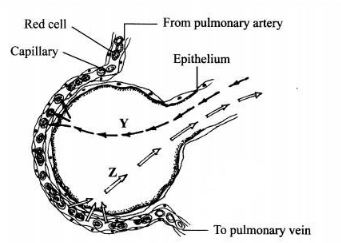
- Identify the gaseous exchange structure
- Identify gases labelled Y and Z
- How does gas labelled Y reach inside of blood capillary
- How does cigarette smoking lead to lung cancer
- (a)Define the following ecological terms
(i) Trophic level (ii) A biotic factors (iii) Food chain
(b)An ecologist carried out a survey to investigate the structure of trophic level in a certain pond. She discovered that trophic level become narrower as you move upward and become broader as you move downward. Give three reasons that bought such condition
- (a)Explain how plants respond positively through the following processes
(i)Nyctinastic process (ii)Thigmotropism process (iii)Seismonastic process
(b)State the main function of vacuole in the amoeba
- Give the name of the muscles which regulate internal body temperature. When the external environment is over heated? Briefly explain by giving three ways.
SECTION C (15 Marks)
Answer question 11
- Describe how the mammalian eye is structurally adapted to its function.
FORM THREE BIOLOGY EXAM SERIES 139
FORM THREE BIOLOGY EXAM SERIES 139
THE PRESIDENT’S OFFICE MINISTRY OF EDUCATION, REGIONAL ADMINISTRATION AND LOCAL GOVERNMENT
COMPETENCY BASED SECONDARY EXAMINATION SERIES
032/1 BIOLOGY FORM THREE
TIME: 3 HOURS SEPT 2022
INSTRUCTIONS
- This paper consist of sections A, B and C, with total of fifteen (15) questions.
- Answer all questions in section A and B and two (2) questions from section C of which question 13 is compulsory.
- All drawing must be in pencil.
- Cellular phone and any unauthorized materials are not allowed in examination room.
- Write your examination number on every page of your answer sheets.
SECTION A (15 Marks)
- For items (i-x), choose the correct answer among the given alternatives and write its letter beside the item number.
- A biologist in his experiment discovered a new cell in a culture. The new cell had cell wall but had no definite nucleus. The cell is mostly likely to be of.
- Kingdom fungi
- Kingdom plantae
- Kingdom monera
- Kingdom animalia
- The blood vessel that carries blood rich in nutrients from the gut to the liver is.
- Pulmonary artery
- Pulmonary vein
- Hepatic artery
- Hepatic portal vein
- Liver artery
- Cardiac muscles are example of.
- System (b) tissue (c) organ (d) organism
- The part of brain which coordinates and supports movement of the human body is.
- Cerebellum (b) cerebrum (c) medulla oblongata (d) hypothalamus
- Which of the following is a list of diseases caused by bacteria?
- Pneumonia, elephantiasis, cholera and typhoid
- Malaria, pneumonia, typhoid and cholera
- Cholera, bilharzias, tuberculosis and pneumonia
- Tuberculosis, small pox, pneumonia and cholera
- Tuberculosis, cholera, pneumonia and typhoid
- The term that best describes animals having both male and female sex organs is.
- Fibroblastic (b) tribloblastic (c) hermaphrodites (d) viviparous
- The fact that the fluid oozes out of a slump after a tree has been felled is evidence to ______ in plants.
- Transport (b) root pressure (c)translocation (d) transpiration stream
- Which substance can be tested by using Benedict’s solution
- Reducing sugar
- Starch
- Lipids
- Protein
- oils
- Which of the following enzymes is produced in the Mouth
- Lipase.
- Salivary amylase
- Sucrose.
- Trypsin
- Maltase.
- Which of the following is the correct order of event?
- Oogenesis – fertilization – ovulation – implantation
- Ovulation – fertilization - oogenesis – ovulation
- Oogenesis – ovulation – fertilization – implantation
- Implantation – oogenesis – fertilization – ovulation
- Oogenesis – ovulation – implantation – fertilization
- Match the responses in list B with the phrases in list A by writing the letter of the correct response.
| LIST A | LIST B |
|
|
SECTION B (60 Marks)
Answer all questions in this section
- (a) Give the meaning of blood compatibility as well as its application in life.
(b) Mention three (3) areas where diffusion occur in the human body and explain to each how it occurs.
- (a) Mention any three members of kingdom monera and to each state one disease it cause.
(b) To each disease in 4(a) above state two ways of their prevention.
(c) How does a pea plant and millet plant differ? Three points
- (a) Which features does the structure for selective reabsorption in human body has that enable it to perform its roles efficiently? Give four points.
(b) “No specialized excretory organs to both plants and animal’s body, no life”. Is this statement true or not? Use four points to support your answer.
(c) Why sometimes a person urinates yellowish urine? Explain.
- (a) Juma has no knowledge how a woman can produce more than one children who are similar or not similar. Use your knowledge of biology to educate him how such condition can occur.
(b) Give two necessity of menstruation in reproduction
- Mwamini believes that all scientific special rooms for scientific studies are equiped similary.With four points,help Mwamini showing her the uniqueness of biological special room for scientific studies and state the uses of such uniqueness stated above.
- Plants are among of biotic components of an ecosystem. Use five points to comment on this statement.
- (a) How does cow and man differ in nature of their alimentary canal? (Give three points).
(b) Human being cannot survive without photosynthesis. Give two reasons to support this statement.
- Mention the types of genetic materials and write three their differences.
- (a) Tatu who is a form one student has given birth to new boy baby due to illegal and unprotected sexual practice and unfortunately she has no knowledge how to feed her baby .Which food do you advice Tatu to feed her baby and how do you think that food is more important to her child. Give four points.
(b) How is sensory neuron adapted to its function (two points).
12. If you put a piece of bread in a wet cupboard after a few days the breast will be covered with organism called fungi.
a) Give the common name of these fungi which grow bread
……………………………………………………………………………………………
b) Outline the three phyla of the Kingdom fungi
i. …………………………………………………………………………………………………
ii. …………………………………………………………………………………………………
iii. ………………………………………………………………………………………………
c) Outline five advantages of Kingdom fungi
i. ………………………………………………………………………………………………
ii. ……………………………………………………………………………………………….
iii. ……………………………………………………………………………………………….
iv. ………………………………………………………………………………………………..
v. ……………………............………………………
SECTION C (25 Marks)
Answer only two questions from this section, the question number 13 is compulsory.
- (a) Draw a well labeled diagram of a light microscope and state the function of the following parts.
- Diaphragm (ii)Mirror (iii) Eye piece
(iv Body tube (v) Condenser
(b) Write five ways of taking care to a microscope.
- Majority of people believes that all fungi are harmful organisms. As a biologist, explain five ways in which fungi are beneficial to human being.
- Discuss on the causes, ways of transmission, symptoms and prevention of gonorrhea.
1 | Page
FORM THREE BIOLOGY EXAM SERIES 94
FORM THREE BIOLOGY EXAM SERIES 94
MINISTRY OF EDUCATION, REGIONAL ADMINISTRATION AND LOCAL GOVERNMENT
COMPETENCE BASED SECONDARY EXAMINATION SERIES
BIOLOGY 1MID TERM EXAMINATION
FORM THREE-AUG/SEPT 2021
Time: 3Hours
Instructions.
- This paper consists of section A, B and C with a total of 15 questions.
- Answer all questions in section A and B and TWO (2) question from section C in which question 13 compulsory.
- All writing should be in blue or black pen, except for diagrams that must be drawn in pencil.
- Cellular phones and any unauthorized materials are not allowed in the examination room.
- Write your number on every page of your answer booklet.
SECTION A (20 Marks)
Answer All questions in this section.
1. For each of the items (i)-(x), choose the correct answer from among the given alternatives and write its letter beside the item number in the answer booklet provided.
(i) A biologist discovered a new cell in a culture. The new cell had a distinct cell wall but it did not have a definite nucleus. The cell is most likely to be:
- Fungi
- Prokaryote
- Protozoa
- Virus
- Eukaryote
(ii)Oxygen debt occurs when:
- Too much carbon dioxide is present in the body.
- The rate of respiration exceeds that of photosynthesis in green plants.
- Alcohol is formed in tissues.
- There is insufficient oxygen in the muscle tissues during strenuous exercise.
- There is insufficient lactic acid in muscle tissues.
(iii) Green plants are known as producers because they:
- produce chlorophyll in chloroplasts
- produce green leaves
- contain fruits and seeds
- grow in fertile soil
- make food from simple stibstances
(iv) Which of the following prevents surfaces of the articulating bones from being worn out by friction?
- Capsular ligament
- Synovial membrane
- Articular cartilage
- Tendon
- Synovial capsule
(v) The best distinction between diastolic and systolic blood pressure is that:
- Diastolic blood pressure is caused by contraction of ventricles while systolic blood pressure is caused by contraction of auricles.
- Diastolic blood pressure causes blood from contracting auricles to flow into ventricles while systolic blood pressure causes blood from contracting ventricles to flow into pulmonary artery and aorta.
- Diastolic blood pressure is the same as systolic blood pressure. Therefore there is no distinction.
- Diastolic blood pressure is lower than systolic blood pressure.
- Diastolic blood pressure is common.
(vi)In green grass there are usually large numbers of green grasshoppers than brown grasshoppers. The best explanation is that the:
- green grasshoppers feel the need of being green to give them protection.
- predators do not capture green grasshoppers as frequently as brown grasshoppers.
- green grass makes the brown grasshopper not to be seen by the predators.
- green grasshoppers obtain enough food from green grass than brown grasshopper.
- green grass stimulates green grsshoppers to reproduce and increase in number faster than brown grasshoppers.
(vii) Why are skeletal muscles usually found in opposing pairs?
- One muscle alone cannot extend a joint
- Muscles can only work by contraction
- One muscle alone cannot flex a joint
- Paired muscles are stronger
- Muscles normally work in antagonistic fashion
(viii) When students were conducting private study at night, lights went off completely. Which of the following changes occurred in the eyes of the students?
- The lens became thicker
- The pupil became larger
- The ciliary muscle relaxed
- The lids close
- The eyes opened wider
(ix) Which hormones produced by the pituitary gland promote ovulation?
- Follicle stimulating hormone (FSH) and lutenizing hormone (LH)
- Lutenizing hormone (LH) and progesterone
- Oestrogen and progesterone
- Progesterone and follicle stimulating hormone (FSH)
- Prolactin and progesterone
(x) A mountaineer develops headache, breathlessness, nausea and vomiting on reaching an altitude of above 4000 metres. This is because:
- his body system is not given time to adjust to the low oxygen pressure.
- the atmospheric pressure as well as the supply of oxygen decreases at higher altitude.
- the increase in the amount of oxygen results into breåthlessness.
- the atmospheric pressure increases at higher altitude and so does the supply of oxygen.
- his body system is not given time to relax due to the increase of atmospheric pressure.
2. Match the items in List A with the List B by writing the letter of the correct responsible beside the item number.
| List A | List B |
| (i)Blind spot (ii)First trophic level (iii)The period of reduced activity during which growth does not occur (iv)Diaphragm flattened (v)Birth control |
|
SECTION B (60 Marks)
Answer all questions in this section.
4. In an experiment to investigate a factor affecting photosynthesis, a potted plant which had been kept in the dark overnight was treated as shown in the diagram below and exposed to light.
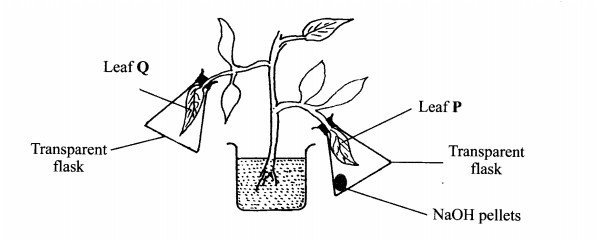
(a) Why was the potted plant kept in the dark overnight? (1 mark)
(b) Which factor was being investigated in the experiment? (1 mark)
(c) (i) Which test did the students perform to con?rm photosynthesis in the leaves labelled P and Q? (1 mark)
(ii) State the results obtained in the leaves labelled P and Q.
P (1 mark)
Q (1 mark)
(iii) Explain the results obtained in the leaves labelled P and Q.
P .........................(1 mark)
Q..........................(l mark)
(d) What was the purpose of leaf Q in the experiment? (1 mark)
4.How do plants get rid of excretory products? Briefly explain three ways.
5. Give four differences that exist between insect pollinated flowers and wind pollinated flowers.
6. (a) How could the body remove or destroy a bacterium that lands:
(i) on the cornea?
(ii) on the hand?
(iii) in the bronchus? (iv) in the stomach?
7. (a) (i) Define the term mitosis.
(ii) Outline the significance of mitosis to organisms.
8. (a) Explain the adaptation of the lungs for gaseous exchange.
(b) What is the biological importance of shivering during cold weather?
(c) Explain why some trees are killed when a ring of bark is removed from their stems.
9. Explain the effects of increased physical activity on the following organ systems:
- Heart
- Lung
- Skin
- Kidney
10. Describe the role of hormones in the human menstrual cycle.
11. Below are diagrams of a cell organelle obtained from different organs of an animal.

(a) (i) For each organelle state an organ in the urinary system where it is likely to be found.
(ii) Give a reason for your answers in (a) (i) above (2 marks)
(b) Name the part of the chloroplast where the following reactions occur:
(i) Carbon(IV) oxide fixation(1 mark)
(ii) Photolysis (1 mark)
12. Explain the survival values of the following tropic responses to plants.
(a) Geotropism (2 marks)
(b) Phototropism. (1 mark)
SECTION C (25 Marks)
Answer two (2) questions from this section. Question 13 is compulsory.
- Explain the functions of the major components of the human skeleton and their adaptations.
- Explain two differences between artificial and natural classification systems and indicate the two merits and demerits for each system..
15. (a) Differentiate between responsible behaviours and risky behaviours.
(b) State two behaviours which may lead to the following risks:
(i) STDs
(ii)HIV infections
(iii)Drug abuse
(iv)Unplanned pregnancies
(c) Suggest how victims of HIV/AIDS can be cared and supported.
FORM THREE BIOLOGY EXAM SERIES 57
FORM THREE BIOLOGY EXAM SERIES 57
THE PRESIDENT'S OFFICE
MINISTRY OF REGIONAL GOVERNMENT AND LOCAL GOVERNMENT
AUGUST-SEPTEMBER EXAMINATION SERIES
BIOLOGY FORM-3
2020
TIME: 2:30 HRS
Instructions
- This paper consists of sections A, B and C with a total of fifteen (15) questions.
- Answer all the questions in sections A and B and two (2) questions from section C of which question 13 is compulsory.
- All writing should be in blue or black pen, except for diagrams that must be drawn in pencil.
- Cellular phones and any unauthorised materials are not allowed in the examination room.
- Write your Examination Number on every page of your answer booklet(s).
SECTION A (15 Marks)
Answer all questions in this section.
1 For each of the items (i) - (x), choose the correct answer from among the given alternatives and write its letter beside the item number in the answer booklet provided.
(i) What is the aim of doing experiment when conducting a scientific investigation?
- Identifying a problem
- Finding a solution
- Testing a hypothesis
- Gathering information
- Recording results
(ii) What is the role of node of ranvier in a neurone?
- To transmit the impulses away from the cell body.
- To insulate the axon and speed up transmission of impulses.
- To transmit nerve impulses from one nerve to another.
- To speed up the transmission of nerve impulses.
- To transmit the nerve impulses towards the cell body.
(iii) flow many gametes are produced from one cell during meiosis?
- Eight
- Two
- Four
- Six
- Ten.
(iv) Which of the following is the excretory organ in human?
- Mouth
- Kidney
- Pancreas
- Stomach
- Anus.
(v) The function of the bright coloured petals in flowers is
- to store nectarines
- to hold sepals in position
- to produce colour of the flower
- to receive pollen grain
- to attract insects for pollination.
(vi) The function of hydrochloric acid in food testing experiment is
- to decolourise food sample
- to test reducing sugar
- to oxidize the food sample
- to neutralize sugary foods
- to hydrolyze complex to simple sugar.
(vi) Goitre is a deficiency disease caused by lack of which element in the diet?
- Carbohydrate
- Iodine
- Vitamin E
- Vitamin C
- Protein.
(vii) The product of anaerobic respiration process in animals is
- lactic acid
- carbondioxide
- alcohol
- water
- oxygen.
(viii) Which disease spread rapidly as a result of poor waste disposal?
- Anemia
- AIDS
- Cholera
- Leukemia
- Small pox.
(x) A voluntary muscle that is capable of relaxing continuously and do not fatigue easily is known as
- skeletal muscle
- biceps
- triceps
- cardiac muscle
- smooth muscle.
2. Match the responses in List B with the phrases in List A by writing the letter of the correct response from List B beside the item number of List A in your answer booklet.
| LIST A | LIST B |
|
|
SECTION B (60 Marks)
Answer all questions in this section.
3. (a) Differentiate the term "Biological apparatus" from "Biology Laboratory".
(b) Briefly explain why the following substances are dangerous?
- Toxic substances
- Highly flammable
- Corrosive substances
- Radioactive substances.
4. (a) State two principles of waste disposal.
(b) Suggest three proper ways of waste disposal in the community.
5. (a) Explain the distinctive features of the Division Filicinophyta.
(b) Draw a well labeled diagram of a fern plant.
6. (a) List any two types of blood cells.
(b) Give two differences between arteries and vein.
7. (a) State three basic principles of waste disposal.
(b) Why poor waste disposal at home is said to cause adverse effects?
8. (a) Give the meaning of the following terms:
- Vegetative propagation.
- Gamete.
(b) Explain the merits and demerits of asexual reproduction in plants.
9. (a) Define the term “osmoregulation”.
(b) Briefly explain the mechanisms of regulating sugar level in the blood.
10. (a) Explain the functions of the vascular system in plants
(b) State three importance of transportation of materials in living things.
11. Consider that you are a medical doctor and you have received a patient whose investigation has diagnosed kidney stones. Suggest to the patient three possible causes and three control measures for kidney stones.
12. Reptiles are organisms whose body temperature is affected by environmental temperature. Briefly explain three ways that help reptile to survive in different weather conditions.
SECTION C
13. Explain any four effects of irresponsible sexual behaviour and suggest five ways of eradicating those behaviours in the community.
14. Describe four similarities and seven differences between insect and wind pollinated flowers.
15. Write an essay on transportation in plants using the following guidelines:
- Meaning of transportation
- The importance of transpiration
- The adaptation of features which enable plants to reduce water loss
FORM THREE BIOLOGY EXAM SERIES 22
FORM THREE BIOLOGY EXAM SERIES 22
Hub App
 For Call,Sms&WhatsApp: 255769929722 / 255754805256
For Call,Sms&WhatsApp: 255769929722 / 255754805256
 For Call,Sms&WhatsApp: 255769929722 / 255754805256
For Call,Sms&WhatsApp: 255769929722 / 255754805256



